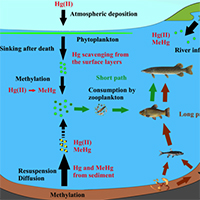Mercury methylation in oxic aquatic macro-environments: a review

Accepted: 27 February 2021
HTML: 107
All claims expressed in this article are solely those of the authors and do not necessarily represent those of their affiliated organizations, or those of the publisher, the editors and the reviewers. Any product that may be evaluated in this article or claim that may be made by its manufacturer is not guaranteed or endorsed by the publisher.
Authors
Mercury methylation in aquatic environments is a key process that incorporates this neurotoxin into the food chain and ultimately the human diet. Mercury methylation is considered to be essentially biotic and mainly driven by sulfate-reducing bacteria present in the bottom sediments in aquatic systems. However, in recent decades, many researchers have shown that this methylation also occurs in oxic layers in conjunction with a high content of particulate organic matter and localized depletion of dissolved oxygen. The goals of this review are to summarize our current understanding of Hg methylation in water columns of both marine and freshwater environments, as well as to highlight knowledge gaps and future research needs. Most of the literature showed that suspended particles (known as marine and lake snow) could be the microenvironment in which Hg methylation could occur across oxic water columns, because they have been recognized as a site of organic matter mineralization and as presenting oxygen gradients around and inside them. To date, the majority of these studies concern marine environments, highlighting the need for more studies in freshwater environments, particularly lacustrine systems. Investigating this new methylmercury production environment is essential for a better understanding of methylmercury incorporation into the trophic chain. In this review, we also propose a model which attempts to highlight the relative importance of a MeHg epilimnetic path over a MeHg benthic-hypolimnetic path, especially in deep lakes. We believe that this model could help to better focus future scientific efforts in limnic environments regarding the MeHg cycle.
Edited by
Diego Fontaneto, CNR-IRSA, Verbania, ItalyHow to Cite

This work is licensed under a Creative Commons Attribution-NonCommercial 4.0 International License.
Similar Articles
- Angela Boggero, Elzbieta Dumnicka, Riccardo Fornaroli, Daniele Paganelli, Silvia Zaupa, Geotargeting spatial and temporal data of Italian freshwater high-altitude macroinvertebrates , Journal of Limnology: Vol. 82 No. s1 (2023): Georeferenced freshwater biodiversity data
- Marija Radojičić, Michal Šorf, Barbora Müllerová, Radovan Kopp, Phytoplankton-zooplankton coupling in a cascade of hypertrophic fishponds , Journal of Limnology: Vol. 82 (2023)
- Giuseppe Alfonso, Riccardo Russo, Genuario Belmonte, First record of the Asian diaptomid Neodiaptomus schmackeri (Poppe & Richard, 1892) (Crustacea: Copepoda: Calanoida) in Europe , Journal of Limnology: Vol. 73 No. 3 (2014)
- Valeria Rossi, Catia Maurone, Giorgio Benassi, Ireneo Ferrari, Reproduction of Daphnia pulex in a Northern Italy pond , Journal of Limnology: Vol. 73 No. 3 (2014)
- Kenneth W. Cummins, Combining taxonomy and function in the study of stream macroinvertebrates , Journal of Limnology: Vol. 75 No. s1 (2016): Proceedings of the 6th National Congress of Limnology
- Neal Michelutti, Andrew L. Labaj, Christopher Grooms, John P. Smol, Equatorial mountain lakes show extended periods of thermal stratification with recent climate change , Journal of Limnology: Vol. 75 No. 2 (2016)
- Agnieszka Szlauer-Łukaszewska, The dynamics of seasonal ostracod density in groyne fields of the Oder River (Poland) , Journal of Limnology: Vol. 73 No. 2 (2014)
- Arpana Yadav, Lalit Kumar Pandey, In situ effects of arsenic, aluminium and chromium stresses on algal periphyton of the river Ganga at Varanasi, India , Journal of Limnology: Vol. 82 (2023)
- Lorenzo Traversetti, Simona Ceschin, Alessandro Manfrin, Massimiliano Scalici, Co-occurrence between macrophytes and macroinvertebrates: towards a new approach for the running waters quality evaluation? , Journal of Limnology: Vol. 74 No. 1 (2015)
- Maximiliano D. Garcia, Nicolás Bonel, Environmental modulation of the plankton community composition and size-structure along the eutrophic intertidal coast of the Río de la Plata estuary, Argentina , Journal of Limnology: Vol. 73 No. 3 (2014)
<< < 33 34 35 36 37 38 39 40 41 42 > >>
You may also start an advanced similarity search for this article.
-
Juanjo RodríguezFrontiers in Marine Science : 2023
-
Thibaut Cossart, Javier Garcia-Calleja, João P. Santos, Elaheh Lotfi Kalahroodi, Isabelle A. M. Worms, Zoyne Pedrero, David Amouroux, Vera I. Slaveykova, Kevin WilkinsonEnvironmental Chemistry : 2022
-
Eric Capo, Claudia Cosio, Elena Gascón Díez, Jean-Luc Loizeau, Elsa Mendes, Thierry Adatte, Sören Franzenburg, Andrea G. BravoWater Research : 2023
-
Laura Marziali, Roberta Piscia, Lucia Valsecchi, Claudio Roscioli, Marina MancaWater : 2022
-
Laura Balzer, Carluvy Baptista-Salazar, Sofi Jonsson, Harald BiesterBiogeosciences : 2023
-
Diva Scuvée, Marisol Goñi-Urriza, Claire Gassie, Bahia Khalfaoui-Hassani, Rémy GuyoneaudMicrobiological Research : 2023
-
María del Carmen Diéguez, Marina Arcagni, Andrea Rizzo, Soledad Pérez Catán, Carolina Soto Cárdenas, Milena Horvat, Sergio Ribeiro GuevaraNatural and Social Sciences of Patagonia : 2022
-
Vincent Noël, Kristin Boye, Hannah R. Naughton, Emily M. Lacroix, Meret Aeppli, Naresh Kumar, Scott Fendorf, Samuel M. WebbFrontiers in Environmental Chemistry : 2024
-
Daniel González-Reguero, Marina Robas-Mora, Agustín Probanza Lobo, Pedro Antonio Jiménez GómezWorld Journal of Microbiology and Biotechnology : 2023

 https://doi.org/10.4081/jlimnol.2021.2007
https://doi.org/10.4081/jlimnol.2021.2007





